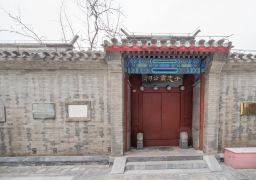The Xianqiao Scenic Area is located at the northern end of Yandang Mountain. Legend has it that it is the place where the immortal Prince Jin rode a crane and arrived. Many scenic spots here are related to this flying immortal: Xianqiao (Immortal Bridge), Xian Pavilion, Immortal Cave, Xian Pavilion Mountain, Danzao Rock, Stone Chessboard… In the 100-square-kilometer scenic area, the mountains and waters are all filled with an immortal aura that penetrates to the marrow.
The Immortal Cave was originally called Beishiliang Cave. It is a natural cave. Legend has it that Prince Jin once rested here, so it was named ‘Immortal Cave’. At the top of this cave, there are Longyan (Dragon Rock), Shiziyan (Lion Rock), Liyuyan (Carp Rock), Jade Rabbit Watching the Moon and other scenes. There is also a spring falling down. The spring water is clear and sweet. Inside the cave, there are three wooden halls and several rooms for housing and kitchens. In the hall, there are Guanyin for giving birth, Tathagata Buddha, God of Wealth and Wenquxing. In the Xianqiao Scenic Area, the stream is called Xianxi (Immortal Stream), the lake is called Longhu (Dragon Lake). In the lake, there is a fairy mountain on an island. The chaste woman who jumped off a cliff and died is called Xian Gu (Fairy Girl). The grotto where she hid is called Xian Gu Cave. Xian Gu Cave is a zigzag-shaped strange cave. It was opened in the first year of Xuantong. It was officially developed in the Xianfeng year. Inside the cave, there are three-story buildings made of brick, wood and stone, mainly used for Taoist activities. On the second floor, there are three stone tablets, all engraved in the Qing Dynasty. The left and right ones are landscape tablets. The middle one is engraved with an imperial decree in the 22nd year of Guangxu in the Qing Dynasty, titled ‘Inscription on the Stele of Chastity and Bravery of Li Gu’. Li Yulian was named a chaste and heroic woman. On the third floor, incense is curling. The Three Pure Ones are enshrined in the middle, and a statue of Fairy Girl is molded on the right. Inside the Xian Gu Cave, the green walls and red cliffs create a different realm. Outside, there are layers of mountains and cliffs towering ten thousand feet. Not far below the cave is the tomb of Fairy Girl. Opening hours: Open all year round from 06:30 to 18:00.Must-see tips: The historical story of ‘Xian Gu Cave’: According to legend, in the Xinyou year of Xianfeng in the Qing Dynasty (1861), Miss Li Yulian, the daughter of Li Gong’ao in Linhai, Taizhou, took refuge in the cave. In the Jiazi year of Tongzhi (1864), she jumped off a cliff and died to resist the looting of bandits. When she died, she sat cross-legged like dust with a calm expression. After Emperor Guangxu learned of this matter, he issued an edict naming her ‘chaste and heroic’. Later, people respected her as ‘Fairy Girl’ and renamed this cave as ‘Xian Gu Cave’. A tomb of Fairy Girl was built at the place where she died.










